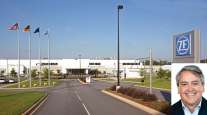ZF Friedrichshafen Makes Offer to Acquire Haldex

ZF Friedrichshafen AG has made an offer for Haldex AB, a supplier of brake products and air suspension systems for commercial vehicles, for about $520 million, or $12 per share.
Its offer represents a 34% premium to the three-month volume-weighted average price prior to the announcement of SAF-Holland’s offer for Haldex on July 14, according to ZF Friedrichshafen.
Bloomberg News reported SAF-Holland SA offered $495 million (4.2 billion kronor) to buy Haldex, a combination of truck-making suppliers that could help match mechanical parts with sensors and electronic components as big rigs increasingly link up to the internet.
The Friedrichshafen, Germany-based company said its offer is conditional on acceptance by Haldex's shareholders to an extent that ZF becomes the owner of more than 90% of the outstanding shares. ZF said its offer has the backing of Göran Carlson, the chairman of Haldex and its largest shareholder, with 5.7% of the total number of shares and votes.
The transaction announced August 4 is further subject to approval from competition authorities. ZF said it will file the transaction with relevant authorities shortly.
With Haldex’s brake systems for commercial vehicles, ZF said it would be able to cover the whole functional chain of commercial vehicles in line with what it calls its “see,” “think” and “act” technology, intended to enable vehicles to behave autonomously, and to improve fuel efficiency and adopt other safety systems used in passenger cars.
“ZF’s strong capabilities within electronics and software development as well as global reach and customer access offer an excellent opportunity to further develop Haldex, thereby allowing Haldex to continue its development of future braking systems and expansion of its current product portfolio,” Magnus Johansson, the spokesman of the Haldex board, said in a statement.
ZF’s products include driveline and chassis technology as well as active and passive safety technology. The company acquired TRW Automotive on May 15, 2015, then integrated it within the organization as the active and passive safety technology division.


